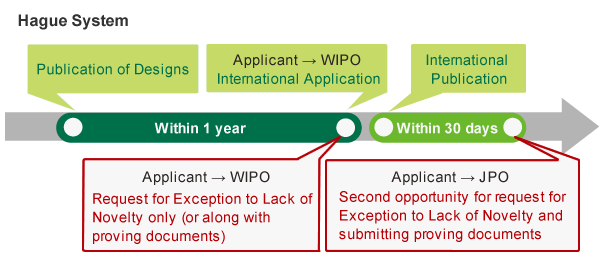The grace period for novelty is known in Japan as the “Exception to Lack of Novelty.” It might be one of the most delicate pitfalls for non-Japanese applicants to navigate. Below are some general precautions, which we hope will be helpful when filing a design application in Japan.
Exceptions to Lack of Novelty of Design (Grace Period in Japan)
Recent Updates
Update 1 effective October 1, 2021
For Hague applications, it has become possible to submit documentation proving for Exceptions to Lack of Novelty with ANNEX II.
Update 2 effective as of January 1, 2024
The procedures to seek for application of Exception to Lack of Novelty to designs have been relaxed. Previously, it was necessary to prove all publications of the design that resulted from the acts of the person entitled to obtain a design registration (including the successor of the right). With the latest revision, the provision on Exceptions to Lack of Novelty can now also be applied to identical or similar designs published after the date of the earliest publication by proving the earliest publication.
General Information
The following list identifies the essential requirements to be eligible for the Exception to Lack of Novelty. All requirements must be fulfilled in order to enjoy the benefits of the Exception, which makes it possible to decrease the likelihood of receiving novelty or creativity rejections from the JPO.
- Grace period
The applicant must file a Japanese application (or a Hague application designating Japan) within one year of the first publication of the design (including similar designs). - Request Submission
An Exception to Lack of Novelty request should be submitted concurrently with the filing of the Japanese application or the Hague application designating Japan, or within 30 days from the date of international publication of the Hague application. - Proof of Publication Documents
Documents proving the public disclosure of the design(s) must be submitted within 30 days of the filing of the Japanese application or within 30 days from the date of international publication of the Hague application. - No Prior Publication
The design should not have been published in a JPO gazette or by any other intellectual property office prior to the Japanese application date.
More Information
When the Grace Period Starts
The one-year grace period is calculated from the actual filing date of the Japanese application, not from the filing date of the priority application.
When to Submit the Request and Proof Documents


Proof of Publication Documents
The documents must include the following information:
- Date of publication;
- Place of publication (If the publication was done online, provide the URL of the webpage);
- Name of the person or organization who published the design;
- Contents of the design published (attach the photographs or images to specify the subject to be proved); and
- Name, address and title of a person who should undersign the certificate (Actual signature is not required).
No Prior Publication
If the subject design is disclosed in official publications such as a patent gazette or design gazette before the first filing date, the Exception to Lack of Novelty does not apply. In this case, it is likely that the Japan Patent Office will reject the application.
For more information, please visit : https://www.jpo.go.jp/e/system/design/hague/proving_doc.html (JPO website)
Please also refer to the following link.
JPO Guidebook for Overseas Users: https://www.jpo.go.jp/resources/report/sonota-info/document/panhu/design_right_injapan.pdf (JPO website)